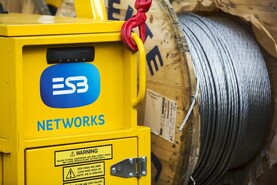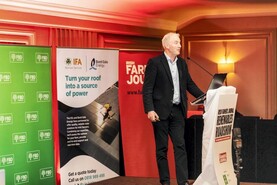Retrofitting your home – lets be honest, it can be a complicated process to understand. From insultation, solar PV to windows, doors and heat pumps, where do you start? From outside in, advises Stephen Donnelly, research and development engineer at Atlantic Technological University Sligo, who has over 10 years’ experience working in the energy sector.
Wall insulation
“External wall insulation can be an expensive energy efficiency measure,” says Stephen, “but it is regarded as the best insulation option as you’re essentially covering your entire home in a blanket.”
“The financial payback might take a while but if you have a cold house, investing in external insulation means you’ll feel the heat straight away.”
Take a step inside. “As homeowners are losing 30% of heat through poorly insulated attic spaces and walls, as well as poorly performing doors and windows, these are also key areas to consider,” says Stephen. Insulating these areas will help you save money on electricity bills by keeping valuable heat in.
Insulation grants range from up to €1,500 for attic insulation; €8,000 for external wall insulation; and €4,500 for internal wall insulation.
Renewable technologies
When your home is well insulated, the next thing to consider is adding renewable technologies to increase your energy demands.
SEAI offers renewable grants of €6,500 for heat pumps; €2,400 for solar PV; and €1,200 for solar thermal.
Heat pumps are the new fancy (and efficient) heating systems that are an alternative to fossil fuel oil or gas boilers. But how exactly do they work?
Electrical heat pumps use a compressor to draw heat from a low temperature source, such as external or ground air to heat the building interior. Using the heating controls in your heat pump system will typically reduce your energy usage by up to 20%.
Stephen says, “For every one unit of energy a heat pump uses, they produce four units of heat in return for use of space heating and hot water.”
Drive around the country and you’ll see more and more black slates on people’s roofs. These solar PV are a good renewable source of energy that enable you to save between €200- €300 per year on your domestic electricity bill. They work by generating a direct current of electricity from the sun. This is then passed through an inverter to convert it into an alternating current, which can be fed into the National Grid or used by the home. This is currently the most popular grant, according to Stephen.
“People like it because it is very simple, they get a number of quotes from a solar PV installer and pick their contractor who will generally be able to do the work within two or three days. Its not very invasive, they might have to put up some scaffolding but mainly, they are working outside the house, so it doesn’t disrupt your living patterns,” he says.

Stevie Donnelly
However, don’t be lured by their popularity. They should be down the list in terms of your retrofit. Stephen says, “You need to have the basics right in order to reap the benefits of the solar panels”.
Often times people will install them when in fact they should be insulating their house better.
“People might not have the right level of attic insulation. They might not even have their cavity walls pumped and they might also benefit from looking at heating controls, controlling the temperature of heat upstairs, downstairs and into hot water. There are lots of things we advise people to do before they look at installing solar PV,” he says.
When will you see your investment back
The most important question homeowners tend to ask is when will they see their retrofitting investment? However, it very much depends on the house.
“If you install solar PV, its regarded that it will take eight or nine years to pay back. That’s shortened now because the price of energy has increased in the last three years. The other benefit you have there is that if you install solar PV, not only will it pay itself back, you will also be able to earn money for the electricity that you export to the grid, if you’re not using it,” says Stephen.
That’s a recent change as people used to want to install a battery to save the energy that they were generating to use later on.
Applying for VPRG and SEAI grants
Savvy consumers that are doing up an old house can draw down both the VPRG and the SEAI grants. You will need to be organised and plan it out accordingly, utilising the SEAI grants for energy upgrades and the VPRG for all other works.
You’ll have to do your homework as it can be difficult to get the right advice on the two grants together but they can operate side-by-side. Your local authority will have a vacant homes officer that you can contact for guidance who will come out, look at the house and assess it to determine which of the works are suitable. It may be worth considering the one stop shop option for your SEAI grants as these professionals are well versed on the grant process.
Farmers Journal renewable roadshow
The upcoming Irish Farmers Journal Renewables Roadshow will provide an overview of the grant aid options available for retrofitting your home, including SEAI individual energy upgrade grants, one-stop shop services and fully funded energy upgrades. We’ll also run through what you need to know about the Vacant Property Refurbishment Grant. Scan the QR code below for more details and to register.

Next week – we look at finance options to help you fund your retrofitting journey including the new Home Energy Upgrade loan scheme and green loans
Read more
ESB Networks seeking electrical apprentices
Irish Farmers Journal to host Renewables Roadshow throughout April
Retrofitting your home – lets be honest, it can be a complicated process to understand. From insultation, solar PV to windows, doors and heat pumps, where do you start? From outside in, advises Stephen Donnelly, research and development engineer at Atlantic Technological University Sligo, who has over 10 years’ experience working in the energy sector.
Wall insulation
“External wall insulation can be an expensive energy efficiency measure,” says Stephen, “but it is regarded as the best insulation option as you’re essentially covering your entire home in a blanket.”
“The financial payback might take a while but if you have a cold house, investing in external insulation means you’ll feel the heat straight away.”
Take a step inside. “As homeowners are losing 30% of heat through poorly insulated attic spaces and walls, as well as poorly performing doors and windows, these are also key areas to consider,” says Stephen. Insulating these areas will help you save money on electricity bills by keeping valuable heat in.
Insulation grants range from up to €1,500 for attic insulation; €8,000 for external wall insulation; and €4,500 for internal wall insulation.
Renewable technologies
When your home is well insulated, the next thing to consider is adding renewable technologies to increase your energy demands.
SEAI offers renewable grants of €6,500 for heat pumps; €2,400 for solar PV; and €1,200 for solar thermal.
Heat pumps are the new fancy (and efficient) heating systems that are an alternative to fossil fuel oil or gas boilers. But how exactly do they work?
Electrical heat pumps use a compressor to draw heat from a low temperature source, such as external or ground air to heat the building interior. Using the heating controls in your heat pump system will typically reduce your energy usage by up to 20%.
Stephen says, “For every one unit of energy a heat pump uses, they produce four units of heat in return for use of space heating and hot water.”
Drive around the country and you’ll see more and more black slates on people’s roofs. These solar PV are a good renewable source of energy that enable you to save between €200- €300 per year on your domestic electricity bill. They work by generating a direct current of electricity from the sun. This is then passed through an inverter to convert it into an alternating current, which can be fed into the National Grid or used by the home. This is currently the most popular grant, according to Stephen.
“People like it because it is very simple, they get a number of quotes from a solar PV installer and pick their contractor who will generally be able to do the work within two or three days. Its not very invasive, they might have to put up some scaffolding but mainly, they are working outside the house, so it doesn’t disrupt your living patterns,” he says.

Stevie Donnelly
However, don’t be lured by their popularity. They should be down the list in terms of your retrofit. Stephen says, “You need to have the basics right in order to reap the benefits of the solar panels”.
Often times people will install them when in fact they should be insulating their house better.
“People might not have the right level of attic insulation. They might not even have their cavity walls pumped and they might also benefit from looking at heating controls, controlling the temperature of heat upstairs, downstairs and into hot water. There are lots of things we advise people to do before they look at installing solar PV,” he says.
When will you see your investment back
The most important question homeowners tend to ask is when will they see their retrofitting investment? However, it very much depends on the house.
“If you install solar PV, its regarded that it will take eight or nine years to pay back. That’s shortened now because the price of energy has increased in the last three years. The other benefit you have there is that if you install solar PV, not only will it pay itself back, you will also be able to earn money for the electricity that you export to the grid, if you’re not using it,” says Stephen.
That’s a recent change as people used to want to install a battery to save the energy that they were generating to use later on.
Applying for VPRG and SEAI grants
Savvy consumers that are doing up an old house can draw down both the VPRG and the SEAI grants. You will need to be organised and plan it out accordingly, utilising the SEAI grants for energy upgrades and the VPRG for all other works.
You’ll have to do your homework as it can be difficult to get the right advice on the two grants together but they can operate side-by-side. Your local authority will have a vacant homes officer that you can contact for guidance who will come out, look at the house and assess it to determine which of the works are suitable. It may be worth considering the one stop shop option for your SEAI grants as these professionals are well versed on the grant process.
Farmers Journal renewable roadshow
The upcoming Irish Farmers Journal Renewables Roadshow will provide an overview of the grant aid options available for retrofitting your home, including SEAI individual energy upgrade grants, one-stop shop services and fully funded energy upgrades. We’ll also run through what you need to know about the Vacant Property Refurbishment Grant. Scan the QR code below for more details and to register.

Next week – we look at finance options to help you fund your retrofitting journey including the new Home Energy Upgrade loan scheme and green loans
Read more
ESB Networks seeking electrical apprentices
Irish Farmers Journal to host Renewables Roadshow throughout April








 This is a subscriber-only article
This is a subscriber-only article











SHARING OPTIONS: